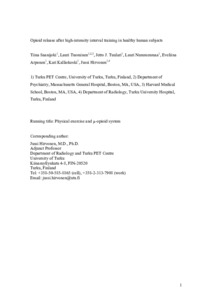Opioid Release after High-Intensity Interval Training in Healthy Human Subjects
Kalliokoski Kari; Tuulari Jetro J; Saanijoki Tiina; Arponen Eveliina; Tuominen Lauri; Hirvonen Jussi; Nummenmaa Lauri
Opioid Release after High-Intensity Interval Training in Healthy Human Subjects
Kalliokoski Kari
Tuulari Jetro J
Saanijoki Tiina
Arponen Eveliina
Tuominen Lauri
Hirvonen Jussi
Nummenmaa Lauri
NATURE PUBLISHING GROUP
Julkaisun pysyvä osoite on:
https://urn.fi/URN:NBN:fi-fe2021042718423
https://urn.fi/URN:NBN:fi-fe2021042718423
Tiivistelmä
Central opioidergic mechanisms may modulate the positive effects of physical exercise such as mood elevation and stress reduction. How exercise intensity and concomitant effective changes affect central opioidergic responses is unknown. We studied the effects of acute physical exercise on the cerebral μ-opioid receptors (MOR) of 22 healthy recreationally active males using positron emission tomography (PET) and the MOR-selective radioligand [11C]carfentanil. MOR binding was measured in three conditions on separate days: after a 60-min aerobic moderate-intensity exercise session, after a high-intensity interval training (HIIT) session, and after rest. Mood was measured repeatedly throughout the experiment. HIIT significantly decreased MOR binding selectively in the frontolimbic regions involved in pain, reward, and emotional processing (thalamus, insula, orbitofrontal cortex, hippocampus, and anterior cingulate cortex). Decreased binding correlated with increased negative emotionality. Moderate-intensity exercise did not change MOR binding, although increased euphoria correlated with decreased receptor binding. These observations, consistent with endogenous opioid release, highlight the role of the μ-opioid system in mediating affective responses to high-intensity training as opposed to recreational moderate physical exercise.
Kokoelmat
- Rinnakkaistallenteet [19207]
